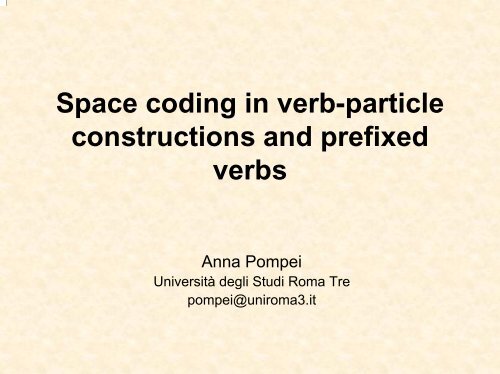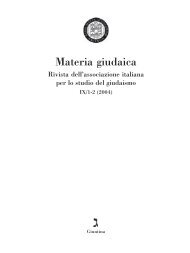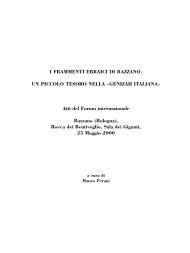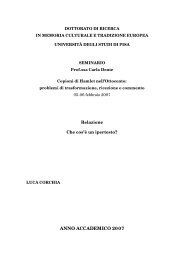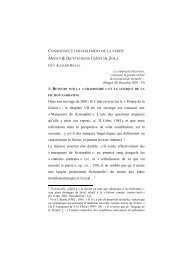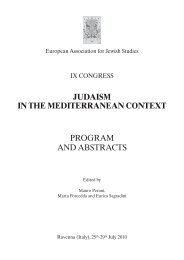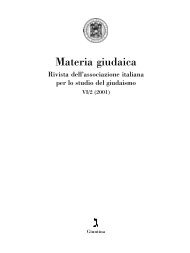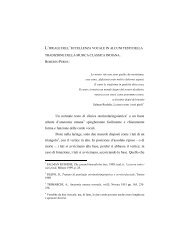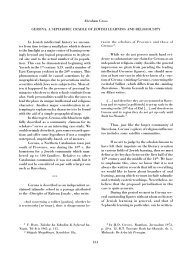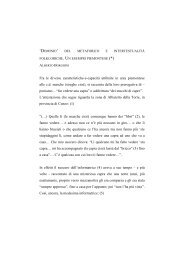Per una tipologia dei composti del greco
Per una tipologia dei composti del greco
Per una tipologia dei composti del greco
You also want an ePaper? Increase the reach of your titles
YUMPU automatically turns print PDFs into web optimized ePapers that Google loves.
Space coding in verb-particle<br />
constructions and prefixed<br />
verbs<br />
Anna Pompei<br />
Università degli Studi Roma Tre<br />
pompei@uniroma3.it
STARTING POINTS:<br />
‣ Prefixed verbs are joined to verb-particle constructions by<br />
a grammaticalization process.<br />
aÄy ei¹j ãIlion hÅlqe [Ο 550 ]<br />
aÄy klisi¿hn<br />
ei¹s<br />
h=lqe [Π 254]<br />
‣ During this process a shift in the semantic value of particles can<br />
take place from a locative meaning to an aspectual meaning.<br />
direction > endpoint > telos<br />
(Adverb-to-TAM chain)<br />
‣ Are there any restrictions on telicization?<br />
‣ Argument structure can block telicization in its abstract value, i.e.<br />
of mere aspectual mark, without any locative meaning.
ITALIAN EVIDENCE<br />
particle<br />
status<br />
valency<br />
change<br />
SoA<br />
telicization<br />
[mettere la valigia in<br />
macchina] TEL<br />
[mettere la valigia su] TEL<br />
><br />
[metter(e) su la valigia] TEL<br />
[sullo scaffale, nel<br />
ripostiglio]<br />
arg. 3 > 2<br />
acc.<br />
><br />
acc.<br />
-<br />
[volare] ATEL<br />
[volar(e) via] TEL<br />
adj. 1 = 1<br />
activ.<br />
><br />
ach.<br />
+<br />
act.<br />
[lavare le macchie] ATEL<br />
[[lavar(e) via] le macchie] TEL<br />
adj. 2=2 ><br />
acc.<br />
+<br />
ach.<br />
[entrare] TEL<br />
[entrar(e) dentro] TEL<br />
adj. 1=1 ><br />
ach.<br />
-
ANCIENT GREEK EVIDENCE<br />
bh= d' aÃr' oÃneiroj e)peiì to\n mu=qon aÃkouse: [Β 16]<br />
‘to go’<br />
bh= de\ kat' Ou)lu/mpoio karh/nwn a)i¿+casa [α 102]<br />
‘to go down from’<br />
katabh/seo di¿frou [Ε 109]<br />
‘to go down from’<br />
xru/sea de/ sf' u(po\ ku/kla e(ka/st% puqme/ni qh=ken [S 375]<br />
‘to set under’<br />
soiì d' au)t%½ pukinw½j u(poqh/somai, aiã ke pi¿qhai: [a 279]<br />
‘to give wise counsel’
LATIN EVIDENCE<br />
allative prefixes > ingressive aspect (ad- in-)<br />
ablative prefixes<br />
><br />
egressive aspect<br />
(ab- ex-)<br />
perlative prefixes<br />
><br />
progressive aspect<br />
(per- pro-)<br />
ex- + eo > exeo ‘to go away’<br />
+ iacio > eicio ‘to throw out’<br />
+ molior > emolior ‘to accomplish’<br />
insanum magnum molior negotium,<br />
metuoque ut hodie possiem emolirier. [Pl., Bacch. 761-762]
CONCLUSIONS<br />
• If the particle is an argument of the verb, when a complex verb<br />
has developed, a particle incorporation can take place; this is in<br />
principle a form of composition (cf. ei)sh=lqe, mettere su, exeo).<br />
• Such an argument incorporation appears to block telicization in<br />
its abstract value missing the locative meaning (cf. mettere su vs.<br />
volare via, lavare via).<br />
• Naturally, telicization does not occur whatsoever if the ‘verb root’<br />
is already telic (cf. e.g. entrare).<br />
• When composition takes place, compound verbs may undergo a<br />
semantic drift (cf. u(poqh/somai ‘to give wise counsel’).<br />
• When a derivation rule applies, prefixes can definitively acquire<br />
aspectual values, in particular telicization (cf. ex- in emolior).
REFERENCES<br />
• Bertinetto, P.M., 1986, Tempo, Aspetto e Azione nel verbo italiano. Il sistema <strong>del</strong>l’indicativo,<br />
Firenze, Accademia <strong>del</strong>la Crusca.<br />
• Cuzzolin, P., 1995, “A proposito di sub vos placo e <strong>del</strong>la grammaticalizzazione <strong>del</strong>le adposizioni”,<br />
Archivio Glottologico Italiano, 122-142.<br />
• García-Hernández, B., 1980, Semántica estructural y lexemática <strong>del</strong> verbo, Reus y Barcelona,<br />
Avesta.<br />
• Horrocks, G. C., 1983, Space and Time in Homer, New York, Arno Press.<br />
• Iacobini, C. – F. Masini, 2007, “Verb-particle constructions and prefixed verbs in Italian: Typology,<br />
diachrony and semantics”, in G. Booij et alii (eds.), On-line Proceedings of he Fifth Mediterranean<br />
Morphology Meeting (MMM5), http://mmm.lingue.unibo.it, 157-184.<br />
• Pompei, A., (2010), “De l’expression de l’espace à l’expression du temps (et de l’aspect) en latin:<br />
le cas des préverbes”, De lingua latina, 3, 1-20.<br />
• Pompei, A., (in prep.), Phrasal verbs and preverbs in Homeric Greek between telicization,<br />
incorporation and valency change”, Proceedings of the 8th International Meeting on Greek<br />
Linguistics, Agrigento, 1-3.10.2009.<br />
• Pompeo, F., 2002, Dall’avverbio localistico alla preposizione in Omero, Roma, Il Calamo.<br />
• Romagno, D., 2003, “Azionalità e transitività: il caso <strong>dei</strong> preverbi latini”, Archivio Glottologico<br />
Italiano, 156-170.<br />
• Simone, R., 1997, “Esistono verbi sintagmatici in italiano?”, Cuadernos de Filología Italiana, 3, 47-<br />
61.<br />
• Simone, R., 2009, “Verbi sintagmatici come categoria e come costruzione”, in M. Cini (ed.), I verbi<br />
sintagmatici in italiano e nelle varietà dialettali. Stato <strong>del</strong>l’arte e prospettive di ricerca, Frankfurt,<br />
Peter Lang, 13-30.<br />
• Talmy, L., 2000, “Lexical Typologies”, in T, Shopen (ed.), Language Typology and Syntactic<br />
Description, III, II ed., Cambridge, Cambridge University Press, 66-168.


